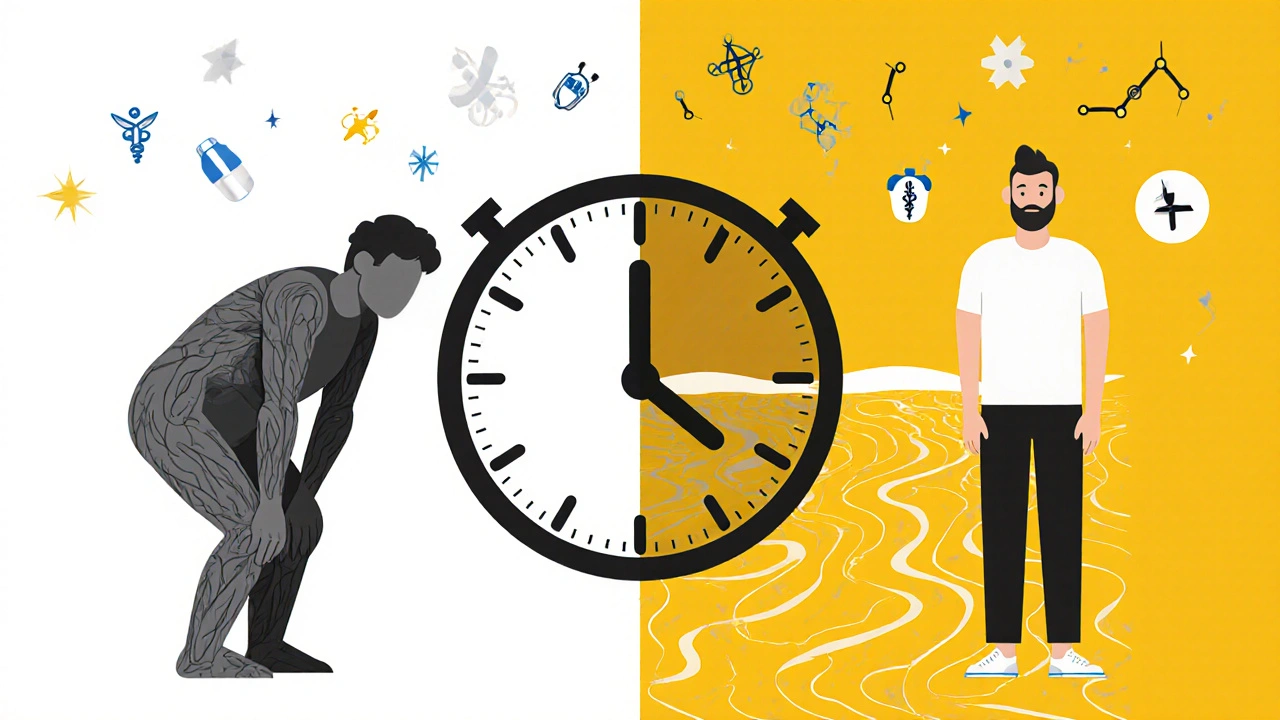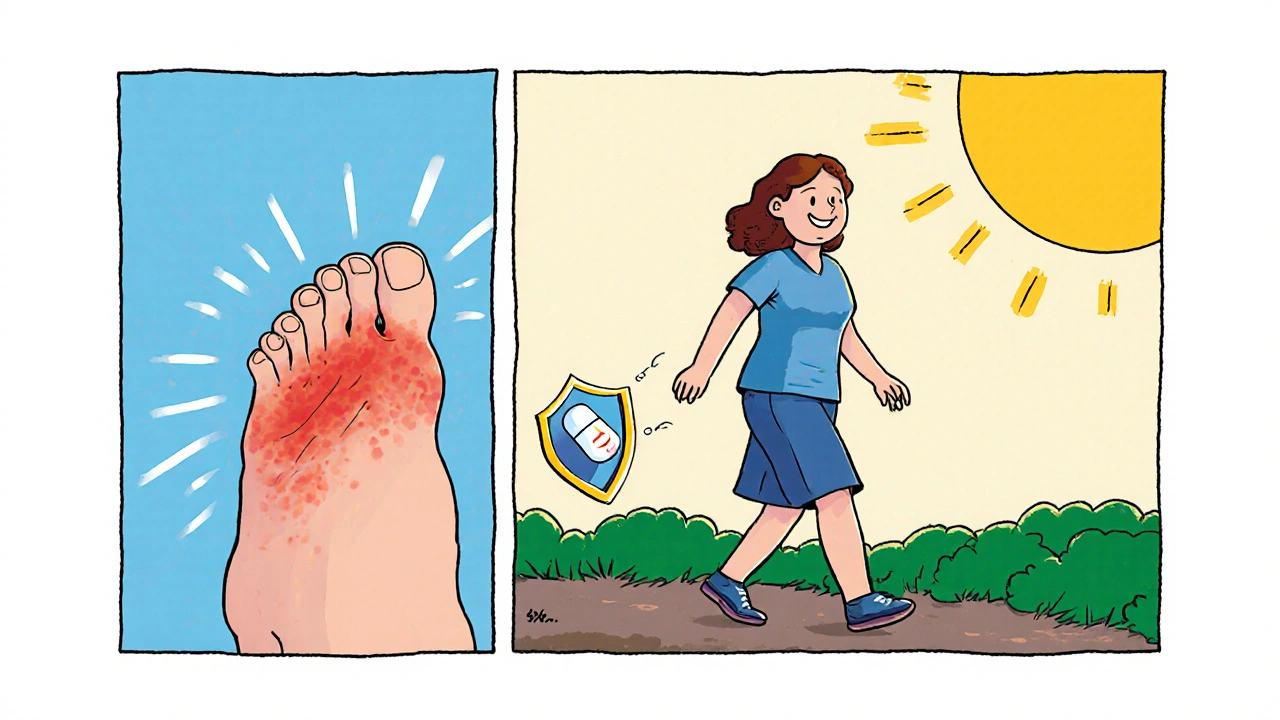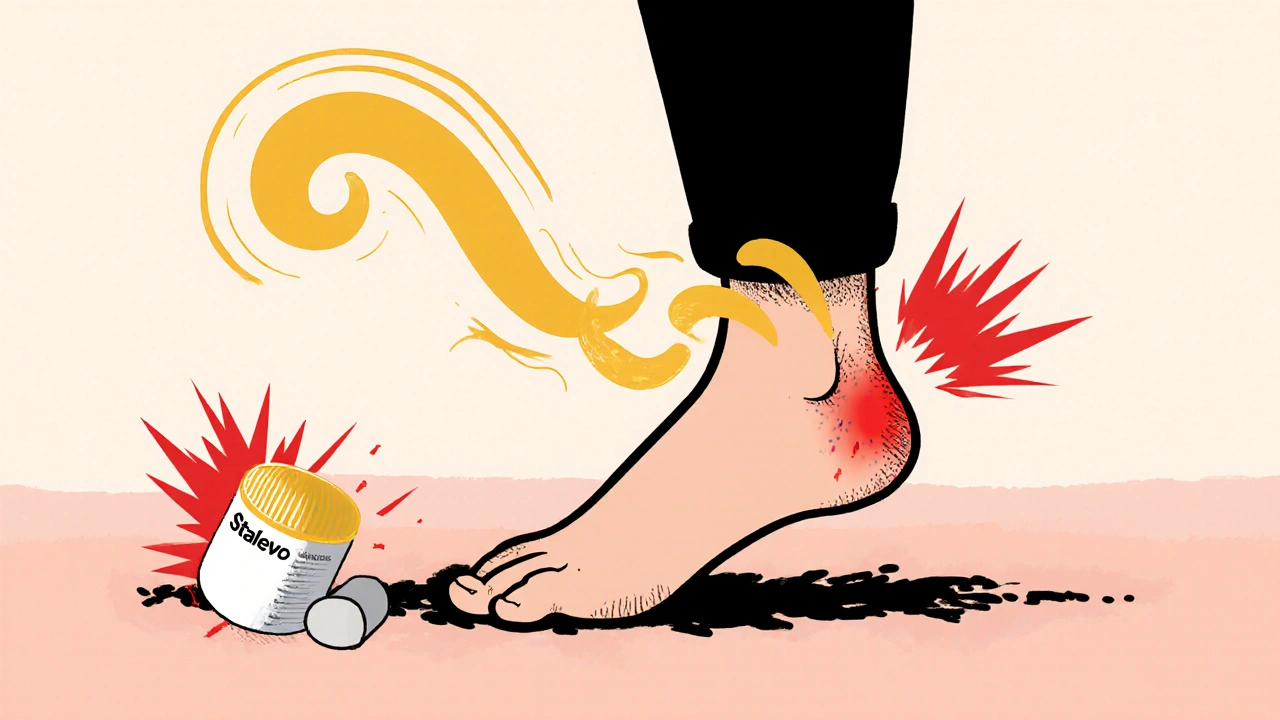For many people with Parkinson’s, the shaking, stiffness, and slow movements aren’t the only things that hurt. Pain is one of the most common, yet least talked about, symptoms. It can feel like a deep ache in the muscles, a sharp cramp in the legs, or a burning sensation that doesn’t go away-even when the tremors do. And while most treatments focus on motor symptoms, there’s growing evidence that a specific combination medication-carbidopa-levodopa-entacapone-can play a real role in easing this pain.
What is carbidopa-levodopa-entacapone?
This drug is sold under the brand name Stalevo and combines three active ingredients in one pill: levodopa, carbidopa, and entacapone. Levodopa is the main building block your brain uses to make dopamine-the chemical that’s missing in Parkinson’s. But when you take levodopa alone, your body breaks it down too fast, and not enough reaches the brain. Carbidopa blocks that early breakdown in the gut and bloodstream, letting more levodopa get through. Entacapone does something similar but works longer, slowing down the enzyme COMT that destroys levodopa after it’s absorbed. Together, they give you more stable, longer-lasting dopamine levels.
This isn’t just about reducing tremors. Stable dopamine means fewer ‘off’ periods-those times when meds wear off and symptoms snap back, often with a vengeance. And it’s during these off periods that pain tends to spike.
Why does Parkinson’s cause pain?
Parkinson’s pain isn’t like a sprained ankle or a headache. It’s often linked to how the disease affects movement and muscle control. Common types include:
- Muscle rigidity pain: Constant tightness in the neck, shoulders, or back that feels like a vice grip.
- Dystonic pain: Involuntary muscle contractions, often in the feet or toes, especially in the morning or when meds are wearing off.
- Central pain: A burning, tingling, or numb feeling that comes from the brain itself, not the muscles.
- Restless legs syndrome: An urge to move the legs, often with uncomfortable sensations.
Research from the Journal of Neurology, Neurosurgery & Psychiatry in 2023 found that over 60% of Parkinson’s patients report pain severe enough to affect daily life. And nearly 70% of that pain happens during ‘off’ periods-when dopamine levels drop between doses.
How carbidopa-levodopa-entacapone reduces pain
The key is duration. Most standard levodopa doses last 2-4 hours. That means you’re cycling in and out of low dopamine states, and with each drop, pain flares up. Carbidopa-levodopa-entacapone extends the effect by 1-2 extra hours on average. That might not sound like much, but for someone with dystonic foot cramps or back pain that hits every 3 hours, those extra 90 minutes can mean the difference between managing pain and being crippled by it.
A 2024 study in Movement Disorders followed 142 patients with Parkinson’s who had persistent pain. Half switched to carbidopa-levodopa-entacapone from regular levodopa/carbidopa. After 12 weeks, 68% reported significant pain reduction-especially during off times. The biggest improvements were in dystonic and musculoskeletal pain. Central pain didn’t improve as much, but for the majority, this combo made a clear difference.
Why does this work? Because pain in Parkinson’s is often motor-related. When muscles lock up or jerk involuntarily, nerves fire pain signals. By smoothing out the dopamine curve, you reduce those abnormal movements-and with them, the pain they cause.
Who benefits most from this combo?
Not everyone with Parkinson’s pain will respond. The best candidates are those who:
- Are already on levodopa/carbidopa but still have ‘off’ periods lasting more than 2 hours a day
- Experience pain that clearly worsens when meds wear off
- Have dystonia, especially in the feet or limbs
- Are not responding well to other pain treatments like physical therapy, NSAIDs, or antidepressants
It’s not a first-line treatment for pain. Doctors usually try physical therapy, stretching, or simple pain relievers first. But if those don’t touch the pain-and it’s tied to your medication cycle-this combo is often the next smart step.

What are the side effects?
Since this is still levodopa-based, side effects are similar to regular levodopa, but sometimes more intense because the dose is higher and lasts longer:
- Nausea (less than with levodopa alone thanks to carbidopa)
- Urine discoloration (harmless, turns urine orange or brown)
- Diarrhea (entacapone can speed up digestion)
- Dyskinesia (involuntary movements)-this is the biggest concern. Longer dopamine exposure can trigger jerking or twitching, especially if the dose is too high.
- Low blood pressure, especially when standing up
One thing to watch: entacapone can interact with certain antidepressants and MAO-B inhibitors. Always tell your doctor about every medication you’re taking, even over-the-counter ones.
How it compares to other options
| Option | How It Works | Best For | Limitations |
|---|---|---|---|
| Carbidopa-Levodopa-Entacapone | Extends levodopa effect, smooths dopamine levels | Pain tied to ‘off’ periods, dystonia | Can cause dyskinesia; not for central pain |
| Regular Levodopa/Carbidopa | Replaces dopamine, short duration | General motor symptoms | Pain often returns between doses |
| Pramipexole/Ropinirole | Dopamine agonists, mimic dopamine | Early-stage pain, restless legs | Sleepiness, impulse control issues |
| Physical Therapy & Stretching | Improves mobility, reduces muscle tightness | Musculoskeletal pain, stiffness | Doesn’t help if pain is from low dopamine |
| Antidepressants (e.g., amitriptyline) | Modulates nerve pain signals | Central pain, neuropathic burning | Slow to work; dry mouth, drowsiness |
Carbidopa-levodopa-entacapone isn’t a magic bullet. But for people whose pain is directly tied to when their meds wear off, it’s often the most direct fix available. It doesn’t treat pain from nerve damage or arthritis-it treats pain from dopamine shortage.
Real-world experience
One patient I spoke with, Maria, 67, from Brisbane, had been on levodopa for 8 years. Her feet would curl painfully every afternoon around 4 p.m.-right when her last dose faded. She tried heat packs, massage, even acupuncture. Nothing helped. Her neurologist switched her to carbidopa-levodopa-entacapone. Within two weeks, the foot cramps vanished. She didn’t have to stop her afternoon walks. She didn’t need extra painkillers. The change wasn’t dramatic in her tremors-but it was life-changing for her pain.
That’s the pattern. This drug doesn’t make you walk faster. But it can make you walk without hurting.

What to ask your doctor
If you’re struggling with pain and think it’s linked to your medication cycle, here’s what to say:
- “My pain gets worse right before my next dose-could this be an ‘off’ period?”
- “Would carbidopa-levodopa-entacapone help extend my good hours?”
- “Could my pain be dystonic? Should we try adjusting my dosing schedule first?”
- “What are the risks of dyskinesia if I switch?”
Your doctor might suggest a ‘medication diary’ for a week-writing down when you take pills, when pain hits, and how bad it is. That’s often the clearest way to prove the connection.
Final thoughts
Parkinson’s pain isn’t just a side effect. It’s a core symptom, and it deserves targeted treatment. Carbidopa-levodopa-entacapone isn’t for everyone. But for those whose pain is tied to the rollercoaster of dopamine levels, it’s one of the most practical, evidence-backed tools we have. It doesn’t cure pain. But it can give you back hours of pain-free time each day-and that’s worth a lot.
Can carbidopa-levodopa-entacapone help with all types of Parkinson’s pain?
No. It works best for pain linked to motor fluctuations-like muscle stiffness, cramps, or dystonia that worsens when levodopa levels drop. It’s less effective for central pain (burning or tingling from brain changes) or pain from arthritis or nerve damage. If your pain doesn’t follow your medication schedule, this drug won’t help much.
How long does it take to see pain relief?
Most people notice a difference in pain patterns within 1-2 weeks, especially if they’re switching from standard levodopa. The full effect usually takes 4-6 weeks as your body adjusts to the longer-lasting dopamine levels. Keep a pain diary during this time to track changes.
Is carbidopa-levodopa-entacapone more expensive than regular levodopa?
Yes, it’s significantly more expensive. A 30-day supply of Stalevo can cost 2-3 times more than generic levodopa/carbidopa. But many insurance plans cover it if you’ve tried standard levodopa without success and have documented ‘off’ periods. Ask your doctor for a prior authorization letter.
Can I take this with other painkillers?
Yes, but carefully. NSAIDs like ibuprofen are generally safe to use alongside it for short-term relief. But avoid combining it with other COMT inhibitors (like opicapone) or certain antidepressants without checking with your doctor. Entacapone can interact with drugs metabolized by the liver.
What if I still have pain after switching to this medication?
Then it’s time to look at other causes. Your pain might not be dopamine-related. It could be from joint issues, nerve damage, or poor posture. Your doctor may recommend physical therapy, a nerve block, or even a trial of gabapentin or amitriptyline. Don’t assume the medication isn’t working-sometimes multiple approaches are needed.
Next steps if you’re considering this medication
Start by tracking your pain for 7 days. Note:
- When you take your meds
- When pain starts and stops
- How bad it is (scale of 1-10)
- What you were doing when it hit
Bring this to your neurologist. If the pattern shows pain peaks during ‘off’ times, ask about switching to carbidopa-levodopa-entacapone. If your doctor is hesitant, ask for a referral to a movement disorder specialist. They see this daily and know exactly when this combo makes sense.
Parkinson’s is more than shaking hands. It’s pain that steals your evenings, your walks, your peace. Carbidopa-levodopa-entacapone doesn’t fix everything. But for many, it fixes the part that keeps them from living.



Rhonda Gentz
28 October / 2025It's wild how we treat Parkinson’s like it’s just about shaking hands. Pain gets ignored like it’s not real because it doesn’t show up on scans. But if your feet are curled into claws at 4 p.m. and you can’t walk without crying, that’s not ‘just part of it’-that’s your nervous system screaming. This med doesn’t fix everything, but it fixes the part that lets you breathe again.